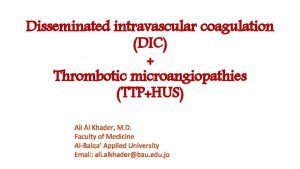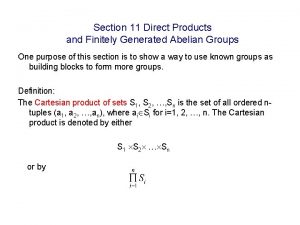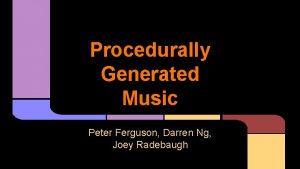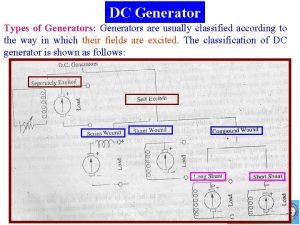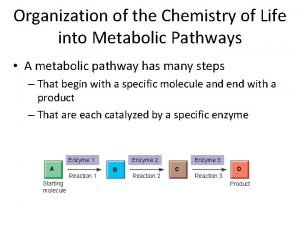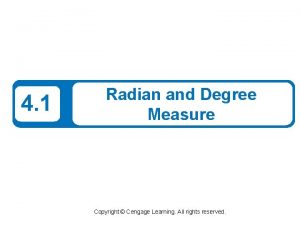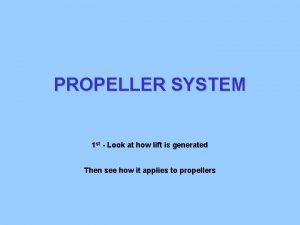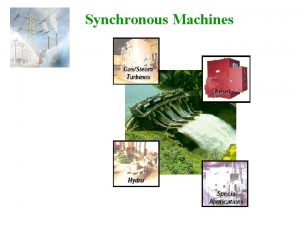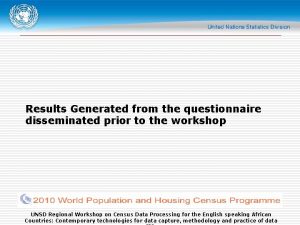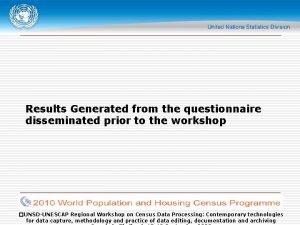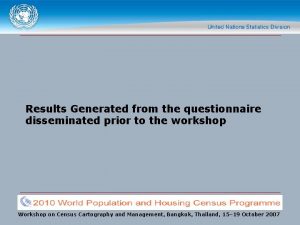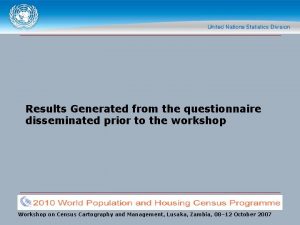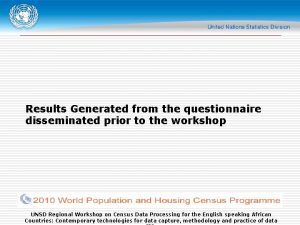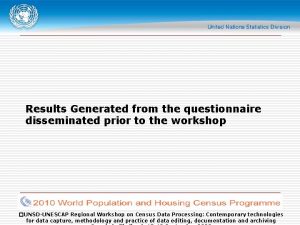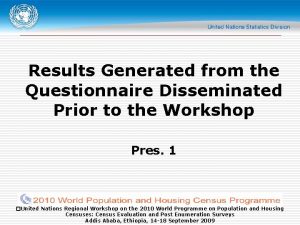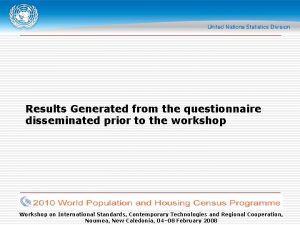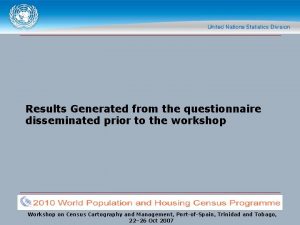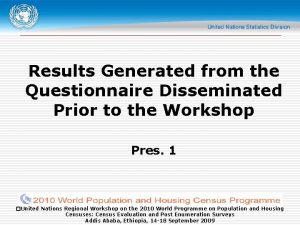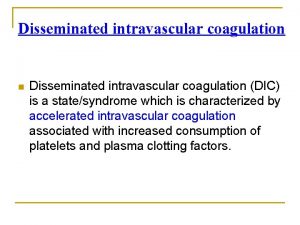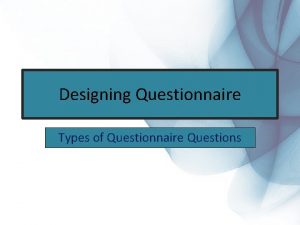Results Generated from the Questionnaire Disseminated Prior to





















- Slides: 21

Results Generated from the Questionnaire Disseminated Prior to the Workshop �United Nations Regional Workshop on the 2010 World Programme on Population and Housing Censuses: Census Evaluation and Post Enumeration Surveys

The Objective of the Questionnaire • To better understand census evaluation activities at the country level • To facilitate the sharing of experience on methods of census evaluation among countries in the region �United Nations Regional Workshop on the 2010 World Programme on Population and Housing Censuses: Census Evaluation and Post Enumeration Surveys

Was PES conducted for 2000 census Yes : 6 No: 8 4 countries did PES for pre-2000 censuses 2 countries did not return the questionnaire • All countries involve National statistical/population census offices in planning and conducting PES • 6 countries where PES team different from census team (Australia, Bolivia, Brazil, Ecuador, Honduras, Peru) • 3 countries used same team for planning census & PES (Panama, Uruguay, Venezuela) �United Nations Regional Workshop on the 2010 World Programme on Population and Housing Censuses: Census Evaluation and Post Enumeration Surveys

Funding • Planned as part of the census programmed in all countries except Venezuela • Funding adequate in 6 countries (Australia, Bolivia, Brazil, Honduras, Panama, Venezuela) �United Nations Regional Workshop on the 2010 World Programme on Population and Housing Censuses: Census Evaluation and Post Enumeration Surveys

Objectives of PES • Census coverage • Characterize missed or over-counted individuals • Estimate undercount for use in estimating official resident population • Learn quality of information collected – content error • Establish ways to correct erroneous census information �United Nations Regional Workshop on the 2010 World Programme on Population and Housing Censuses: Census Evaluation and Post Enumeration Surveys

Institutions responsible for PES and staff used • National statistical office involved in all countries • PES team different from census team in all countries except 4 (Panama, Paraguay, Uruguay, Venezuela) �United Nations Regional Workshop on the 2010 World Programme on Population and Housing Censuses: Census Evaluation and Post Enumeration Surveys

Recruitment and training of PES staff • Three countries selected enumerators and supervisors directly from those used in census (Ecuador, Honduras, Uruguay) • Permanent staff used as supervisors in Australia and Uruguay • Selection criteria includes: Location, experience, academic qualification Recruitment examination • Training periods: 1 -7 days �United Nations Regional Workshop on the 2010 World Programme on Population and Housing Censuses: Census Evaluation and Post Enumeration Surveys

PES sampling designs • • Multi-stage, stratification, approaches Design stages: 1 -3 (mostly 2) – – – Australia: Three stages Bolivia: Two stages with sampling proportional to size Brazil, Peru: Two stages Ecuador, Panama: Two-stages with stratification Honduras, Paraguay, Uruguay: Stratification (one stage only) �United Nations Regional Workshop on the 2010 World Programme on Population and Housing Censuses: Census Evaluation and Post Enumeration Surveys

Sample size for 1 st stage units • In many cases EAs were the primary sampling units • Range of sample sizes 60 EAs in Honduras and 5000 EAs in Australia 1% of EAs in Uruguay and 20% of EAs in Panama 27642 individuals from 7340 households in Paraguay �United Nations Regional Workshop on the 2010 World Programme on Population and Housing Censuses: Census Evaluation and Post Enumeration Surveys

Domains of analysis • Wide range of domains used – National; Rural; Urban – Other domains States/territories, region/province Age, sex, marital status, urban/rural, cities indigenous status, country of birth �United Nations Regional Workshop on the 2010 World Programme on Population and Housing Censuses: Census Evaluation and Post Enumeration Surveys

Matching methods and documentation of rules • Matching method –Manual: 5 (Australia, Brazil, Honduras, Panama, Paraguay) –Computer: 1 (Bolivia) –Combination: 3 (Ecuador, Peru, Uruguay) • Documentation of rules –Yes: 6 (Australia, Brazil, Ecuador, Honduras, Paraguay, Peru) –No: 3 (Bolivia, Panama, Uruguay) �United Nations Regional Workshop on the 2010 World Programme on Population and Housing Censuses: Census Evaluation and Post Enumeration Surveys

Field reconciliation visits Yes: 4 (Australia, Brazil, Ecuador, Honduras) No: 4 (Panama, Paraguay, Peru, Uruguay) Unknown: Venezuela �United Nations Regional Workshop on the 2010 World Programme on Population and Housing Censuses: Census Evaluation and Post Enumeration Surveys

Some of the coverage measures used were • • • Coverage rate only (2 countries – Ecuador, Honduras) Net coverage rate (2 country – Paraguay, Peru) Coverage & net coverage rate (2 countries – Australia, Brazil) Omission rate (1 country - Bolivia) Panama did not calculate due to problems in methodology �United Nations Regional Workshop on the 2010 World Programme on Population and Housing Censuses: Census Evaluation and Post Enumeration Surveys

For content analysis the following were considered • • Estimating undercount and over-count by a variety of demographic categories Counts of misclassification between categories Rate of net difference Index of gross change Index of net change Percentage of identically classified Error of content Agreement �United Nations Regional Workshop on the 2010 World Programme on Population and Housing Censuses: Census Evaluation and Post Enumeration Surveys

Producing report to inform lay users • Planned to produce reports for lay users (5 countries - Australia, Bolivia, Brazil, Paraguay, Peru) • Not planned to produce reports (Ecuador, Honduras, Panama, Uruguay) • All countries that planned to produce reports did so • Most countries 4 -10 months from date of data collection to publication of PES report • The longest period to produce report was taken by Ecuador (about 2 years) �United Nations Regional Workshop on the 2010 World Programme on Population and Housing Censuses: Census Evaluation and Post Enumeration Surveys

To achieve independence for PES: • Different interviewers and supervision arrangements (Australia, Brazil) • No lists created in Census used in PES selection or interviewing processes • Independent planning and execution (Bolivia, Ecuador, Honduras, Peru) • Confidentiality on PES sample area (Brazil) • Different periods (Uruguay) �United Nations Regional Workshop on the 2010 World Programme on Population and Housing Censuses: Census Evaluation and Post Enumeration Surveys

Highlight of lessons learned • Australia: evaluated the potential for computer matching To be introduced in the next round (subject to successful development) • Bolivia: Methodology verification • Brazil: Improve cartography and supervision; undercount rates are used in the next PES sample design • Ecuador: Improve capacity and using imputation techniques �United Nations Regional Workshop on the 2010 World Programme on Population and Housing Censuses: Census Evaluation and Post Enumeration Surveys

Highlight of lessons learned (continued) • Honduras: Need for adequate capacity, independence, budget and logistical support • Paraguay: Need for a separate budget, representative sample for each district and some outsourcing • Peru: Need for larger PES coverage and budget • Uruguay: Independence, high quality personnel, enough time and budget �United Nations Regional Workshop on the 2010 World Programme on Population and Housing Censuses: Census Evaluation and Post Enumeration Surveys

PES for 2010 round • 6 countries are planning to do PES (Australia, Brazil, Ecuador, Honduras, Paraguay, Uruguay) • 5 countries are not planning to do PES (Bolivia, Chile, Costa Rica, Panama, Peru) • Will measure coverage using demographic methods (Costa Rica) �United Nations Regional Workshop on the 2010 World Programme on Population and Housing Censuses: Census Evaluation and Post Enumeration Surveys

Some of the objectives mentioned for PES for 2010 round • Provide an independent check on Census coverage • Identify characteristics of persons missed or over-counted • Produce estimates of undercount for use in estimating resident population • Estimate content error (quality of information) • Measure coverage and quality of information at province level and other domains • Use results to correct census results, calculate population projections the �United Nations Regional Workshop on the 2010 World Programme on Population and Housing Censuses: Census Evaluation and Post Enumeration Surveys

END Thank You �United Nations Regional Workshop on the 2010 World Programme on Population and Housing Censuses: Census Evaluation and Post Enumeration Surveys
 Hus dic
Hus dic After a node has prepared an lsp it must be disseminated to
After a node has prepared an lsp it must be disseminated to Disseminated intravascular coagulation pathophysiology
Disseminated intravascular coagulation pathophysiology What is abelian group
What is abelian group Procedurally generated music
Procedurally generated music Kesler science properties of waves answer key
Kesler science properties of waves answer key Demagnetizing and cross magnetizing
Demagnetizing and cross magnetizing Chemistry of life
Chemistry of life What are presentation graphics programs?
What are presentation graphics programs? How electricity is generated
How electricity is generated Computer generated reports
Computer generated reports Mobile user-generated content
Mobile user-generated content Relocation loader in system software
Relocation loader in system software Image by generated photos
Image by generated photos What is the angle generated by a clockwise rotation?
What is the angle generated by a clockwise rotation? Recent amendments in companies act
Recent amendments in companies act User generated content journalism
User generated content journalism Fine pitch vs coarse pitch propeller
Fine pitch vs coarse pitch propeller Electric current is generated due to
Electric current is generated due to Difference between alternator and synchronous motor
Difference between alternator and synchronous motor Spontaneously generated funds
Spontaneously generated funds Diễn thế sinh thái là
Diễn thế sinh thái là
